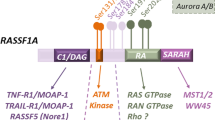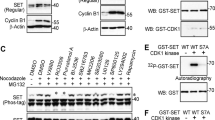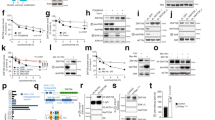Abstract
The RAS association domain family 1A (RASSF1A) gene is silenced by DNA methylation in over 50% of all solid tumors of different histological types. However, the biochemical function of the RASSF1A protein is unknown. We show that RASSF1A colocalizes with microtubules in interphase and decorates spindles and centrosomes during mitosis. RASSF1A has a strong cytoprotective activity against the microtubule-destabilizing drug nocodazole, and against cold-treatment in vivo. Conversely, loss of RASSF1 in RASSF1−/− mouse embryonic fibroblasts renders the cells more sensitive to nocodazole-induced depolymerization of microtubules. The domain required for both microtubule association and stabilization was mapped to a 169 amino-acid fragment that contains the RAS association domain. Overexpression of RASSF1A induces mitotic arrest at metaphase with aberrant mitotic cells reminiscent of such produced by the microtubule-stabilizing drug paclitaxel (taxol), including monopolar spindles, or complete lack of a mitotic spindle. Altered microtubule stability in cells lacking RASSF1A is likely to affect spindle assembly and chromosome attachment, processes that need to be carefully controlled to protect cells from genomic instability and transformation. In addition, knowledge of the microtubule-targeting function of RASSF1 may aid in the development of new anticancer drugs.
This is a preview of subscription content, access via your institution
Access options
Subscribe to this journal
Receive 50 print issues and online access
$259.00 per year
only $5.18 per issue
Buy this article
- Purchase on Springer Link
- Instant access to full article PDF
Prices may be subject to local taxes which are calculated during checkout








Similar content being viewed by others
Abbreviations
- DAPI:
-
4,6-diamidino-2-phenylindole
- MEF:
-
mouse embryonic fibroblast
- MTOC:
-
microtubule-organizing center
- RASSF1A:
-
RAS association domain family 1A
References
Abbondanzo SJ, Gadi I and Stewart CL . (1993). Methods Enzymol., 225, 803–823.
Agathanggelou A, Honorio S, Macartney DP, Martinez A, Dallol A, Rader J, Fullwood P, Chauhan A, Walker R, Shaw JA, Hosoe S, Lerman MI, Minna JD, Maher ER and Latif F . (2001). Oncogene, 20, 1509–1518.
Anand S, Penrhyn-Lowe S and Venkitaraman AR . (2003). Cancer Cell, 3, 51–62.
Burbee DG, Forgacs E, Zochbauer-Muller S, Shivakumar L, Fong K, Gao B, Randle D, Kondo M, Virmani A, Bader S, Sekido Y, Latif F, Milchgrub S, Toyooka S, Gazdar AF, Lerman MI, Zabarovsky E, White M and Minna JD . (2001). J. Natl. Cancer Inst., 93, 691–699.
Byun DS, Lee MG, Chae KS, Ryu BG and Chi SG . (2001). Cancer Res., 61, 7034–7038.
Cahill DP, Lengauer C, Yu J, Riggins GJ, Willson JK, Markowitz SD, Kinzler KW and Vogelstein B . (1998). Nature, 392, 300–303.
Chan MW, Chan LW, Tang NL, Lo KW, Tong JH, Chan AW, Cheung HY, Wong WS, Chan PS, Lai FM and To KF . (2003). Int. J. Cancer, 104, 611–616.
Chen Z, Otto JC, Bergo MO, Young SG and Casey PJ . (2000). J. Biol. Chem., 275, 41251–41257.
Dammann R, Li C, Yoon JH, Chin PL, Bates S and Pfeifer GP . (2000). Nat. Genet., 25, 315–319.
Dammann R, Schagdarsurengin U, Strunnikova M, Rastetter M, Seidel C, Liu L, Tommasi S and Pfeifer GP . (2003). Histol. Histopathol., 18, 665–677.
Dammann R, Takahashi T and Pfeifer GP . (2001a). Oncogene, 20, 3563–3567.
Dammann R, Yang G and Pfeifer GP . (2001b). Cancer Res., 61, 3105–3109.
Dreijerink K, Braga E, Kuzmin I, Geil L, Duh FM, Angeloni D, Zbar B, Lerman MI, Stanbridge EJ, Minna JD, Protopopov A, Li J, Kashuba V, Klein G and Zabarovsky ER . (2001). Proc. Natl. Acad. Sci. USA, 98, 7504–7509.
Duensing S and Münger K . (2002). Oncogene, 21, 6241–6248.
Hergovich A, Lisztwan J, Barry R, Ballschmieter P and Krek W . (2003). Nat. Cell Biol., 5, 64–70.
Honorio S, Agathanggelou A, Wernert N, Rothe M, Maher ER and Latif F . (2003). Oncogene, 22, 461–466.
Hsu LC and White RL . (1998). Proc. Natl. Acad. Sci. USA, 95, 12983–12988.
Jordan MA, Thrower D and Wilson L . (1992). J. Cell Sci., 102 (Part 3), 401–416.
Jordan MA, Toso RJ, Thrower D and Wilson L . (1993). Proc. Natl. Acad. Sci. USA, 90, 9552–9556.
Jordan MA, Wendell K, Gardiner S, Derry WB, Copp H and Wilson L . (1996). Cancer Res., 56, 816–825.
Khokhlatchev A, Rabizadeh S, Xavier R, Nedwidek M, Chen T, Zhang XF, Seed B and Avruch J . (2002). Curr. Biol., 12, 253–265.
Kim ST, Lim DS, Canman CE and Kastan MB . (1999). J. Biol. Chem., 274, 37538–37543.
Kok K, Naylor SL and Buys CH . (1997). Adv. Cancer Res., 71, 27–92.
Kuzmin I, Gillespie JW, Protopopov A, Geil L, Dreijerink K, Yang Y, Vocke CD, Duh FM, Zabarovsky E, Minna JD, Rhim JS, Emmert-Buck MR, Linehan WM and Lerman MI . (2002). Cancer Res., 62, 3498–3502.
Kuzmin I, Liu L, Dammann R, Geil L, Stanbridge EJ, Wilczynski SP, Lerman MI and Pfeifer GP . (2003). Cancer Res., 63, 1888–1893.
Lee MG, Kim HY, Byun DS, Lee SJ, Lee CH, Kim JI, Chang SG and Chi SG . (2001). Cancer Res., 61, 6688–6692.
Lerman MI and Minna JD . (2000). Cancer Res., 60, 6116–6133.
Li YC, Chen CR and Chang EC . (2000). Genetics, 156, 995–1004.
Liu L, Yoon JH, Dammann R and Pfeifer GP . (2002). Oncogene, 21, 6835–6840.
Lo KW, Kwong J, Hui AB, Chan SY, To KF, Chan AS, Chow LS, Teo PM, Johnson PJ and Huang DP . (2001). Cancer Res., 61, 3877–3881.
Lotti LV, Ottini L, D’Amico C, Gradini R, Cama A, Belleudi F, Frati L, Torrisi MR and Mariani-Costantini R . (2002). Genes Chromosomes Cancer, 35, 193–203.
Lusher ME, Lindsey JC, Latif F, Pearson AD, Ellison DW and Clifford SC . (2002). Cancer Res., 62, 5906–5911.
Maruyama R, Toyooka S, Toyooka KO, Harada K, Virmani AK, Zochbauer-Muller S, Farinas AJ, Vakar-Lopez F, Minna JD, Sagalowsky A, Czerniak B and Gazdar AF . (2001). Cancer Res., 61, 8659–8663.
Michel LS, Liberal V, Chatterjee A, Kirchwegger R, Pasche B, Gerald W, Dobles M, Sorger PK, Murty VV and Benezra R . (2001). Nature, 409, 355–359.
Morrissey C, Martinez A, Zatyka M, Agathanggelou A, Honorio S, Astuti D, Morgan NV, Moch H, Richards FM, Kishida T, Yao M, Schraml P, Latif F and Maher ER . (2001). Cancer Res., 61, 7277–7281.
Newton AC . (1995). Curr. Biol., 5, 973–976.
Ortiz-Vega S, Khokhlatchev A, Nedwidek M, Zhang XF, Dammann R, Pfeifer GP and Avruch J . (2002). Oncogene, 21, 1381–1390.
Pfeifer GP, Yoon JH, Liu L, Tommasi S, Wilczynski SP and Dammann R . (2002). Biol. Chem., 383, 907–914.
Ponting CP and Benjamin DR . (1996). Trends Biochem. Sci., 21, 422–425.
Rieder CL, Cole RW, Khodjakov A and Sluder G . (1995). J. Cell Biol., 130, 941–948.
Schagdarsurengin U, Gimm O, Hoang-Vu C, Dralle H, Pfeifer GP and Dammann R . (2002). Cancer Res., 62, 3698–3701.
Schagdarsurengin U, Wilkens L, Steinemann D, Flemming P, Kreipe HH, Pfeifer GP, Schlegelberger B and Dammann R . (2003). Oncogene, 22, 1866–1871.
Segal M and Clarke DJ . (2001). BioEssays, 23, 307–310.
Sekido Y, Ahmadian M, Wistuba II, Latif F, Bader S, Wei MH, Duh FM, Gazda AF, Lerman MI and Minna JD . (1998). Oncogene, 16, 3151–3157.
Shivakumar L, Minna J, Sakamaki T, Pestell R and White MA . (2002). Mol. Cell. Biol., 22, 4309–4318.
Spugnardi M, Tommasi S, Dammann R, Pfeifer GP and Hoon DS . (2003). Cancer Res., 63, 1639–1643.
Tommasi S, Dammann R, Jin SG, Zhang XF, Avruch J and Pfeifer GP . (2002). Oncogene, 21, 2713–2720.
Toyooka S, Carbone M, Toyooka KO, Bocchetta M, Shivapurkar N, Minna JD and Gazdar AF . (2002). Oncogene, 21, 4340–4344.
van Engeland M, Roemen GM, Brink M, Pachen MM, Weijenberg MP, de Bruine AP, Arends JW, van den Brandt PA, de Goeij AF and Herman JG . (2002). Oncogene, 21, 3792–3795.
Vavvas D, Li X, Avruch J and Zhang XF . (1998). J. Biol. Chem., 273, 5439–5442.
Wagner KJ, Cooper WN, Grundy RG, Caldwell G, Jones C, Wadey RB, Morton D, Schofield PN, Reik W, Latif F and Maher ER . (2002). Oncogene, 21, 7277–7282.
Zhang YJ, Ahsan H, Chen Y, Lunn RM, Wang LY, Chen SY, Lee PH, Chen CJ and Santella RM . (2002). Mol. Carcinog., 35, 85–92.
Zumbrunn J, Kinoshita K, Hyman AA and Nathke IS . (2001). Curr. Biol., 11, 44–49.
Acknowledgements
We thank R Barber, M Lee, and P Salvaterra for assistance with microscopy, S Bates for culturing cells, W Tsark and F Silva for ES cell electroporation and blastocyst injection, L Brown and C Spalla for FACS analysis, S-G Jin for plasmid construction, and J Shively, CJ Chen, and CL Jiang for instructive discussions. This work was supported by NIH Grant CA88873 (to GPP) and by BMBF Grant FKZ01ZZ0104 (to RD).
Author information
Authors and Affiliations
Corresponding author
Rights and permissions
About this article
Cite this article
Liu, L., Tommasi, S., Lee, DH. et al. Control of microtubule stability by the RASSF1A tumor suppressor. Oncogene 22, 8125–8136 (2003). https://doi.org/10.1038/sj.onc.1206984
Received:
Revised:
Accepted:
Published:
Issue Date:
DOI: https://doi.org/10.1038/sj.onc.1206984
Keywords
This article is cited by
-
Identification of RASSF1A promoter hypermethylation as a biomarker for hepatocellular carcinoma
Cancer Cell International (2020)
-
Microtubule-associated tumor suppressors as prognostic biomarkers in breast cancer
Breast Cancer Research and Treatment (2020)
-
RASSF1A, puppeteer of cellular homeostasis, fights tumorigenesis, and metastasis—an updated review
Cell Death & Disease (2019)
-
A role for RASSF1A in tunneling nanotube formation between cells through GEFH1/Rab11 pathway control
Cell Communication and Signaling (2018)
-
Tumor suppressor C-RASSF proteins
Cellular and Molecular Life Sciences (2018)



